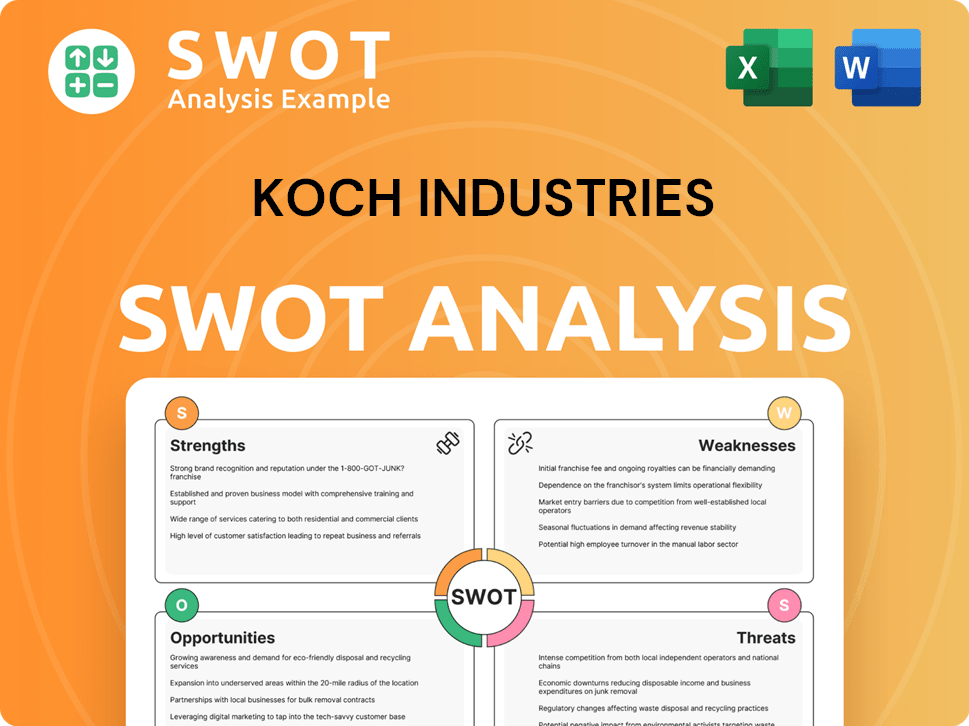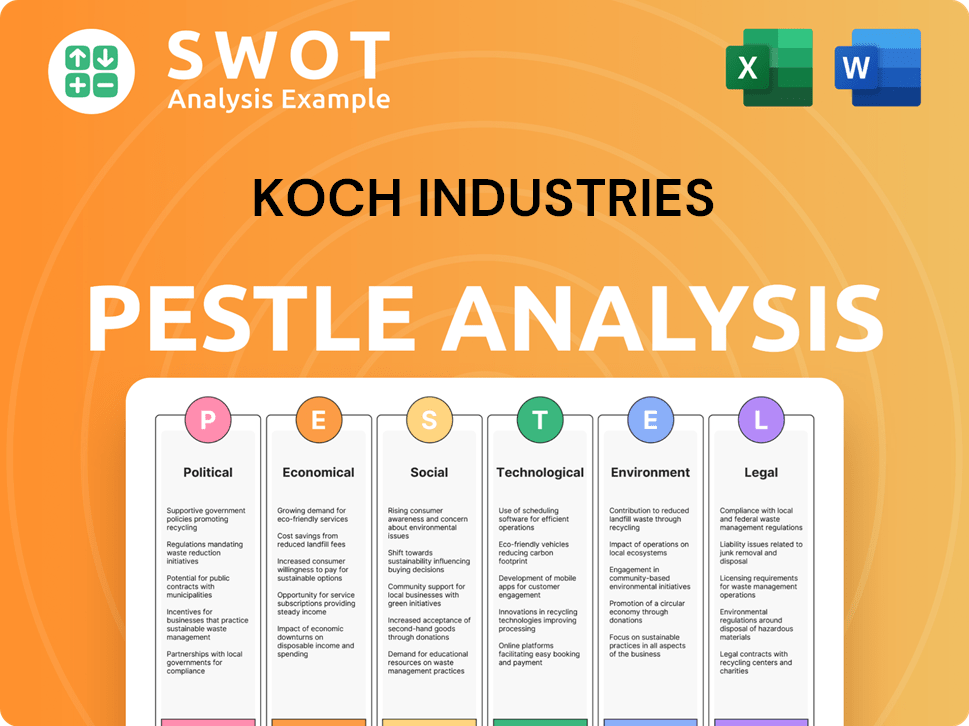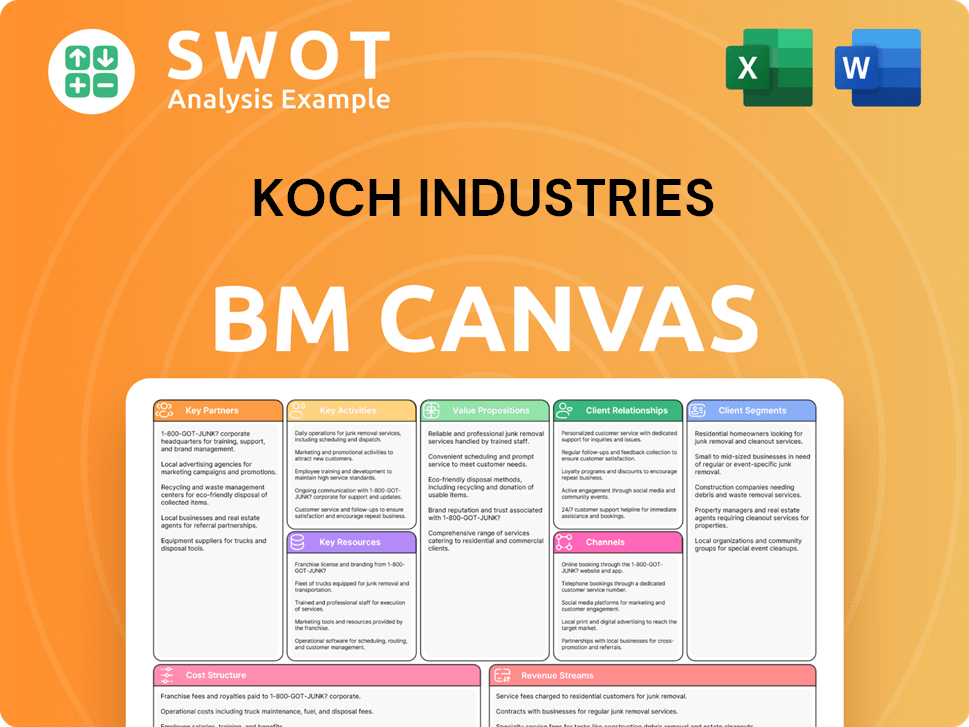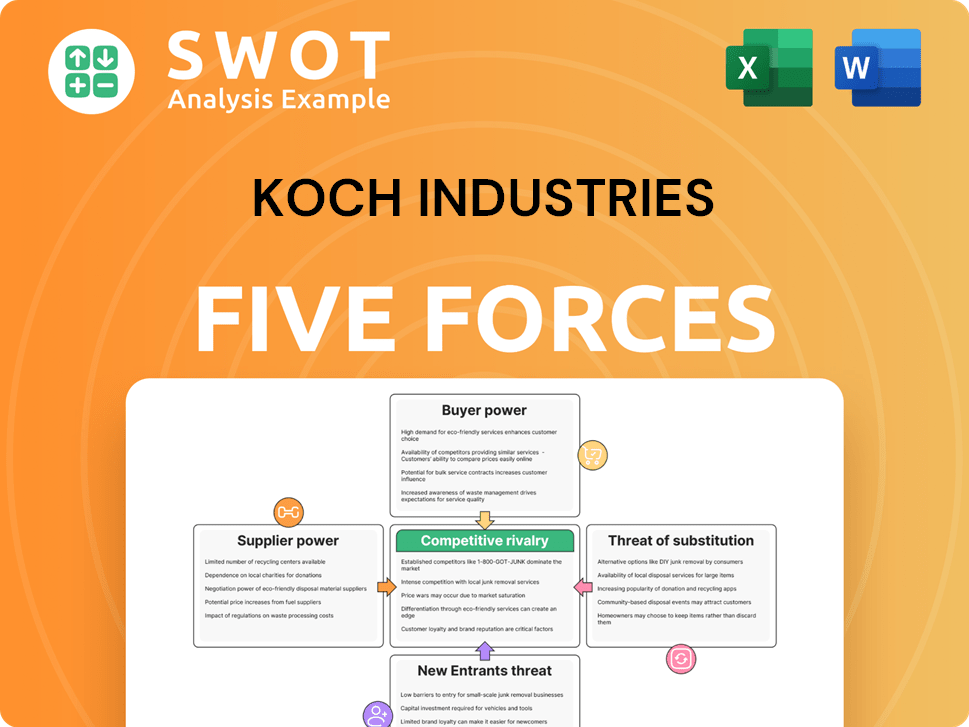Koch Industries Bundle
Can You Outmaneuver Koch Industries in the Market?
Koch Industries, a privately held behemoth, casts a long shadow across diverse sectors, demanding keen market observation. From its humble beginnings in oil refining, the company has exploded into a global powerhouse. Understanding the Koch Industries SWOT Analysis is crucial for any investor or strategist.

This exploration delves into the intricate Koch Industries competitive landscape, revealing its key Koch Industries competitors and strategic positioning. We'll dissect its Koch Industries industry presence, providing a comprehensive Koch Industries overview and examining its effective Koch Industries business strategy. Prepare to uncover insights into Koch Industries' market analysis and how it maintains its impressive market share.
Where Does Koch Industries’ Stand in the Current Market?
Koch Industries holds a strong market position, largely due to its highly diversified portfolio and substantial operational scale. The company's financial health is evident, with approximate revenues of $125 billion reported in 2023. This financial strength supports its broad market presence across multiple sectors.
The company's operations span various sectors, including manufacturing, refining, chemicals, energy, agriculture, electronics, and technology. Key subsidiaries like Georgia-Pacific, Flint Hills Resources, INVISTA, Molex, and Infor contribute significantly to its widespread influence. This diversification helps mitigate risks associated with market fluctuations in any single sector.
Koch Industries serves a diverse customer base, including industrial businesses, energy companies, agricultural sectors, and direct consumers. This broad customer reach generally limits the impact of any single customer. However, concentrated buyers in sectors like petrochemicals can exert significant pressure on the company. For a deeper understanding of its customer base, consider exploring the Target Market of Koch Industries.
Koch Industries has demonstrated strategic shifts in its positioning. A notable move was its complete withdrawal from global oil and refined products trading operations in April 2025. This strategic decision redirects resources towards metals trading, ocean freight trading, and natural gas-related products.
The company's commitment to energy management is further highlighted by its recognition as an EPA 2024 ENERGY STAR Partner of the Year for the fourth consecutive year. This demonstrates a strong focus on resource efficiency and sustainability within its operations.
Koch Industries' competitive landscape is shaped by its diverse business segments and the strategies it employs to maintain its market position. The company's ability to adapt and shift resources is crucial for navigating the complexities of various industries. This adaptability is essential for maintaining a competitive edge.
- Diversification: Koch Industries operates in multiple sectors, reducing dependency on any single market.
- Strategic Investments: The company continuously evaluates and adjusts its portfolio, as seen with the shift away from oil trading.
- Operational Efficiency: Focus on resource efficiency, as demonstrated by the ENERGY STAR partnership, enhances its competitiveness.
- Market Adaptation: Koch Industries responds to market challenges by reallocating resources and entering new markets.
Koch Industries SWOT Analysis
- Complete SWOT Breakdown
- Fully Customizable
- Editable in Excel & Word
- Professional Formatting
- Investor-Ready Format

Who Are the Main Competitors Challenging Koch Industries?
Understanding the Koch Industries competitive landscape requires a sector-by-sector analysis due to its diversified business model. The company faces distinct rivals in energy, chemicals, paper, packaging, and other industries. This analysis explores Koch Industries' competitors and their impact on the company's strategic positioning and market share.
Koch Industries' market analysis reveals a complex interplay of established players, emerging trends, and evolving customer preferences. Competition is driven by factors such as pricing, innovation, brand recognition, and distribution networks. The competitive landscape is continually reshaped by mergers, acquisitions, and the rising importance of sustainability, affecting Koch Industries' business strategy.
In the energy and chemicals sectors, Koch Industries' industry faces strong competition from major players. ExxonMobil is a key competitor. According to recent reports, ExxonMobil has stated reductions in funding to certain climate denial organizations, but continues to support numerous groups within the climate denial movement. Dow Inc. also presents significant competition in the chemical sector. These competitors challenge Koch Industries through various means, including pricing strategies, innovation in product development, brand recognition, and distribution networks.
ExxonMobil and Dow Inc. are major rivals in the energy and chemicals sectors. These companies compete through pricing, innovation, and distribution. Increased competition in the global chemical market has led to lower switching costs for customers.
International Paper is a significant competitor in the paper and packaging industry. Competition involves pricing, product development, and distribution networks. The paper and packaging industry is subject to changes in consumer demand and environmental regulations.
The rising emphasis on sustainability and environmental considerations is a critical factor. Customers are increasingly favoring eco-friendly alternatives. New entrants can disrupt the landscape through innovative business models.
Mergers and alliances reshape competitive dynamics. In January 2024, Hillman Solutions Corp. acquired a provider of rope and twine, chain, and wire rope from Koch Industries, Inc. This highlights ongoing consolidation in various segments.
Koch Industries' planned $3.6 billion acquisition of OCI Global's Iowa Fertilizer Company in late 2023 faced opposition. Concerns focused on further concentration in the fertilizer industry, already highly consolidated. The top four firms control 75% of fertilizer markets.
The demand for eco-friendly products is increasing. This trend may diminish demand for certain Koch products. Companies are adapting to meet changing consumer preferences and environmental regulations.
Koch Industries' competitive analysis report reveals that the company faces challenges from various fronts. These include pricing strategies, innovation, brand recognition, and distribution networks. The company must navigate a landscape shaped by mergers, acquisitions, and sustainability trends.
- Pricing Strategies: Competitors often use competitive pricing to gain market share.
- Innovation: Product development and technological advancements are crucial.
- Brand Recognition: Strong brand presence influences customer loyalty.
- Distribution Networks: Efficient distribution ensures product availability.
Koch Industries PESTLE Analysis
- Covers All 6 PESTLE Categories
- No Research Needed – Save Hours of Work
- Built by Experts, Trusted by Consultants
- Instant Download, Ready to Use
- 100% Editable, Fully Customizable

What Gives Koch Industries a Competitive Edge Over Its Rivals?
Understanding the competitive landscape of Koch Industries involves examining its core strengths and strategic initiatives. The company's approach to business, its diverse portfolio, and its investments in innovation are key factors. This analysis provides insights into how Koch Industries maintains its position in various markets and how it adapts to changes.
Koch Industries' competitive advantages are rooted in its unique operational model, extensive diversification, and commitment to innovation. The company's Market-Based Management® (MBM®) framework emphasizes decentralized decision-making and individual accountability, which enables it to create value for others. This approach has allowed the company to grow significantly and adapt to changing market conditions. For a detailed look at their growth strategy, consider reading about the Growth Strategy of Koch Industries.
The company's vertically integrated operations across numerous sectors provide significant economies of scale and supply chain strengths, allowing it to maximize profits and reinvest in long-term growth. Koch Industries also prioritizes substantial investments in innovation and technology. For example, its subsidiaries are investing in battery technologies and related raw materials, chemicals, and recycling, aligning with the electrification trend.
MBM® is a core differentiator, emphasizing decentralized decision-making and individual accountability. It fosters a culture of creating value for others. This framework has enabled Koch Industries to adapt to changing market conditions effectively.
Koch Industries operates across numerous sectors, providing economies of scale. Vertical integration enhances supply chain strengths, maximizing profits. This diversification supports long-term growth and resilience.
Koch Industries invests heavily in innovation and technology. Subsidiaries are involved in battery technologies, raw materials, and recycling. This aligns with the electrification trend and future market demands.
The acquisition of Infor in April 2020 strengthened Koch's digital capabilities. Infor's ERP solutions serve over 26,000 global entities. This enhances operational efficiency and supports digital transformation.
Koch Industries' competitive edge is built on several key strengths. These include its unique management philosophy, diversified business operations, and strategic investments in technology and innovation. These advantages allow the company to adapt to market changes and maintain a strong position.
- Market-Based Management®: Drives decentralized decision-making and individual accountability.
- Vertical Integration: Enhances supply chain efficiency and maximizes profitability.
- Innovation Focus: Investments in battery technology and digital transformation.
- Brand Recognition: Strong brand and customer loyalty, particularly through subsidiaries.
- Operational Efficiency: Commitment to environmental stewardship and resource management.
Koch Industries Business Model Canvas
- Complete 9-Block Business Model Canvas
- Effortlessly Communicate Your Business Strategy
- Investor-Ready BMC Format
- 100% Editable and Customizable
- Clear and Structured Layout

What Industry Trends Are Reshaping Koch Industries’s Competitive Landscape?
The competitive landscape for Koch Industries is shaped by industry trends, including technological advancements, regulatory changes, and evolving consumer preferences. These factors influence the company's strategic direction and its ability to maintain a strong market position. Understanding these dynamics is crucial for assessing Koch Industries' long-term prospects. The company faces both risks and opportunities as it navigates these changes, requiring adaptability and strategic foresight.
The "gray wave" of retiring veteran operators and experts in manufacturing facilities presents a significant challenge. With up to 40% of operating knowledge potentially leaving in the next five years, operational transformation and digital tools become essential. Global economic conditions, including geopolitical tensions and trade wars, pose ongoing risks. However, these challenges also create opportunities for Koch Industries to explore new markets and invest in product innovation.
Technological advancements, such as smart manufacturing (projected to reach $384 billion by 2024), are transforming operations. Regulatory changes, including stricter environmental standards like the EU's Circular Economy Act expected in 2026, impact business practices. Consumer demand for sustainable products drives the need for green alternatives.
The retirement of experienced workers poses a significant challenge to operational knowledge. Geopolitical tensions and trade wars create economic risks. Adapting to evolving environmental regulations and consumer preferences requires ongoing investment and strategic adjustments.
Investment in digital transformation and data analytics can improve customer experiences and operational efficiencies. Exploring new markets and regions can diversify revenue streams. Strategic partnerships and product innovation, such as in high-performance chemicals (global market projected to reach $38 billion by 2025), offer growth potential.
Koch Industries is investing in digital transformation and data analytics. The company is actively addressing environmental regulations through sustainability initiatives, including reducing greenhouse gas emissions and waste. Strategic pivots, like moving away from oil and fuel trading, reflect an adaptability to market shifts.
Koch Industries' competitive position is evolving through its focus on innovation, operational excellence, and strategic adaptation to dynamic industry trends. The company is investing in digital transformation and data analytics for personalized customer experiences and operational efficiencies. Their partnership in Direct Lithium Extraction (DLE) is positioned to transform global lithium production.
- Investment in digital transformation and data analytics.
- Commitment to sustainability initiatives to reduce emissions and waste.
- Strategic partnerships and product innovation.
- Adaptation to market shifts, such as pivoting away from oil and fuel trading.
The Revenue Streams & Business Model of Koch Industries reveals how the company is strategically positioned within the energy market. Koch Industries’ response to market challenges is highlighted by its proactive approach to technological advancements and sustainability. The company's competitive analysis report indicates a strong emphasis on diversification and innovation.
Koch Industries Porter's Five Forces Analysis
- Covers All 5 Competitive Forces in Detail
- Structured for Consultants, Students, and Founders
- 100% Editable in Microsoft Word & Excel
- Instant Digital Download – Use Immediately
- Compatible with Mac & PC – Fully Unlocked

Related Blogs
- What are Mission Vision & Core Values of Koch Industries Company?
- What is Growth Strategy and Future Prospects of Koch Industries Company?
- How Does Koch Industries Company Work?
- What is Sales and Marketing Strategy of Koch Industries Company?
- What is Brief History of Koch Industries Company?
- Who Owns Koch Industries Company?
- What is Customer Demographics and Target Market of Koch Industries Company?
Disclaimer
All information, articles, and product details provided on this website are for general informational and educational purposes only. We do not claim any ownership over, nor do we intend to infringe upon, any trademarks, copyrights, logos, brand names, or other intellectual property mentioned or depicted on this site. Such intellectual property remains the property of its respective owners, and any references here are made solely for identification or informational purposes, without implying any affiliation, endorsement, or partnership.
We make no representations or warranties, express or implied, regarding the accuracy, completeness, or suitability of any content or products presented. Nothing on this website should be construed as legal, tax, investment, financial, medical, or other professional advice. In addition, no part of this site—including articles or product references—constitutes a solicitation, recommendation, endorsement, advertisement, or offer to buy or sell any securities, franchises, or other financial instruments, particularly in jurisdictions where such activity would be unlawful.
All content is of a general nature and may not address the specific circumstances of any individual or entity. It is not a substitute for professional advice or services. Any actions you take based on the information provided here are strictly at your own risk. You accept full responsibility for any decisions or outcomes arising from your use of this website and agree to release us from any liability in connection with your use of, or reliance upon, the content or products found herein.